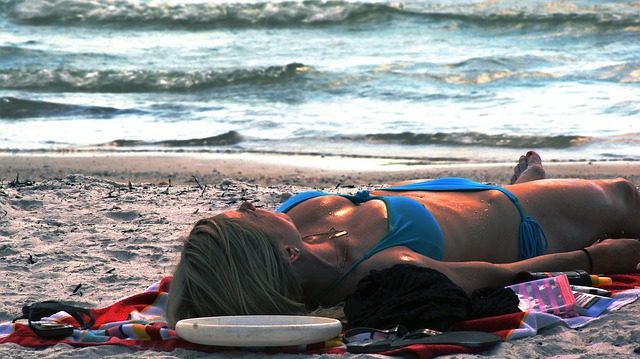
As we eagerly make summer plans, our fond memories of sand castles, backyard barbecues and lazy afternoons poolside can be quickly eclipsed by headlines about sun exposure and skin cancer. It’s distressing. On the one hand, we want to heed warnings about melanoma. On the other, it’s hard to resist the allure of coconut oil.
For those of us who are naturally pale, there’s no question that a summer tan makes us look—and feel—healthy and vibrant, especially since the image of tanned, radiant bodies has been drummed into us by Hollywood and the media. What’s a body to do?
Some scientists argue that solar ultraviolet (UV) exposure is essential to the body’s production of vitamin D, which could actually prevent certain cancers and bone diseases. These doctors feel that continually shielding ourselves from UV rays might be detrimental to overall health.
But most dermatologists, as well as the Skin Cancer Foundation, vehemently insist that the risk of developing skin cancer from UV radiation vastly outweighs any potential health benefits of extended exposure to sunshine. Experts say that it’s never a good idea to seek out the sun. While the sun’s UVA and UVB rays cause sunburn and can lead to skin cancer, UVA rays (also present in tanning booths) are particularly dangerous because they penetrate the skin so deeply.
In fact, more than 2 million people in the U.S. will develop skin cancer this year, and 1 in 58 Americans will be at lifetime risk for potentially deadly melanoma. In the U.S., melanoma is the number-one form of cancer in young adults 25 to 29. And it’s the second most common skin cancer in adolescents. Unfortunately, millions of people continue to bask in the sun because they just don’t believe skin cancer will ever happen to them.
SUN SAFETY TIPS:
1. Thinking about using a tanning bed before you hit the beach? Think again. Tanning beds release high levels of dangerous UVA rays.
2. Between 10 am and 4 pm, avoid the sun and use sunscreen. Even if you’re just going on a picnic or taking a walk, you still need sunscreen.
3. If you’re naturally dark skinned, you might be less prone to burning, but you require sun protection.
4. About 30 minutes before you go outdoors, generously apply water-resistant sunscreen to dry skin, even on cloudy days. (Dry skin is less likely to burn than wet skin.) Re-apply every two hours.
5. Wear a broad-spectrum sunblock (which blocks UVA and UVB rays) with an SPF rating of at least 30. Minimal SPF protection found in some makeup is not sufficient protection. You need at least 30 SPF, found in some facial moisturizers.
6. Never apply baby oil or other oil-based products to the skin, and avoid lotions that contain para-aminobenzoic acid (PABA). Some health experts believe such lotions can cause genetic damage when exposed to sunlight.
7. Enjoy the outdoors wisely. Choose a cabana. Choose a shade tree. Avoid spending time with skin exposed in outdoor areas that reflect light, i.e., water, snow and sand.
8. To conserve sunscreen, wear a cap or wide-brimmed hat, and consider lightweight sun-protective clothing that is widely available online and through retailers like REI.
9. Teach kids early on that it’s not cool to get a tan.
10. Each season, check the expiration date on your sunscreen and buy a fresh bottle when in doubt.
Learn the “ABCDEs” of melanoma at aad.org. For more sun protection tips, visit suncancer.org.

